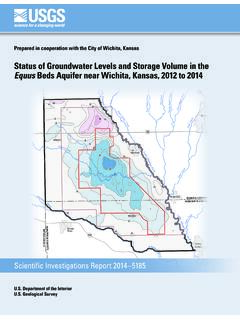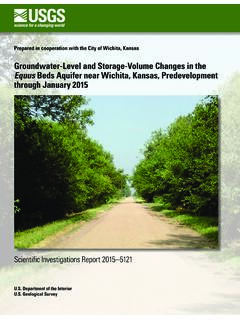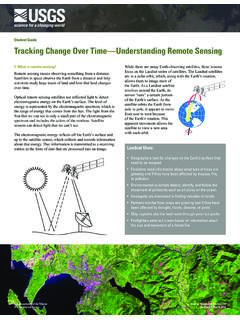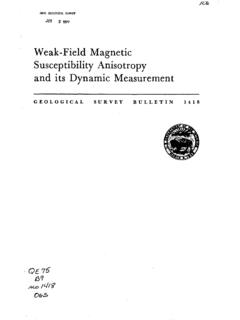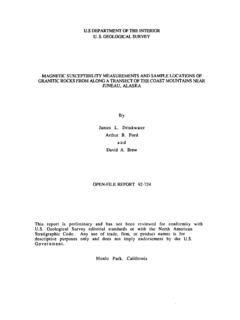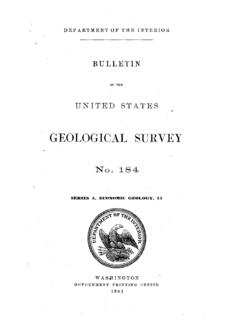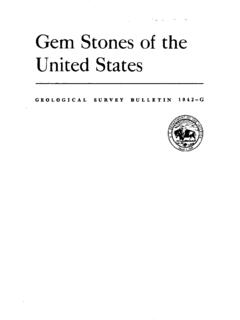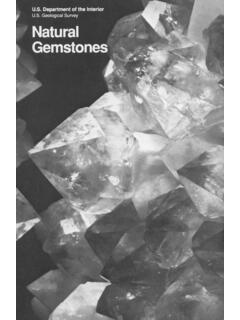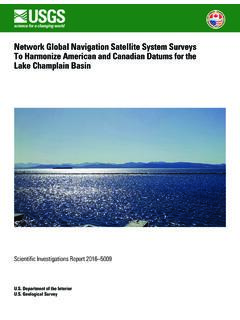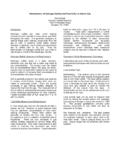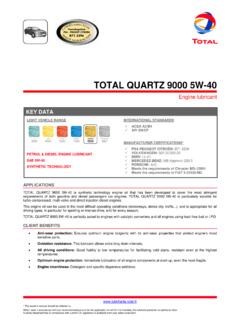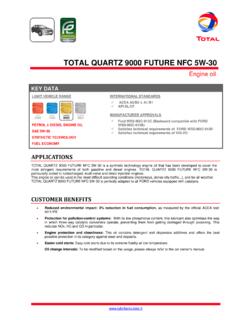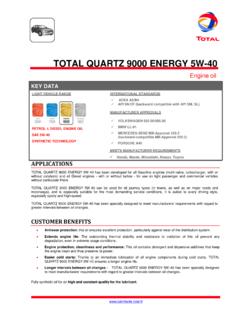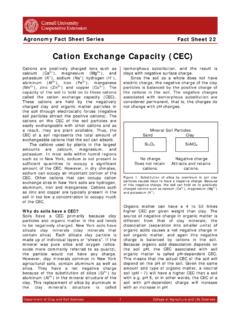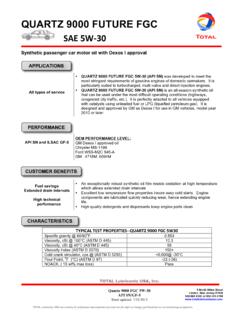Transcription of Porosity and Bulk Density of Sedimentary Rocks
1 Porosity and bulk Density of Sedimentary Rocks ~y G. EDWARD MANGER :ONTRIBUTIONS TO GEOCHEMISTRY GEOLOGICAL SURVEY BULLETIN 1144-E Prepared partly on behalf of the Atomic Energy Commission UNITED STATES GOVERNMENT PRINTING OFFICE, WASHINGTON : 1963 UNITED STATES DEPARTMENT OF THE INTERIOR STEW ART L. UDALL, Secretary GEOLOGICAL SURVEY Thomas B. Nolan, Director For sale by the Superintendent of Documents, Government Printing Office Washington, , 20402 CONTENTS Page Abstract-------------------------------- --------------------------E1 Introduction_____ 1 Methods of Porosity determination _____ ------_____ -------_ 45 lteferences----------------------------- ---------------------------47 TABLES TABLE 1. Sandstone, siltstone, quartzite, chert, and conglomerate_____ E5 2. Limestone, dolomite, chalk, and marble_____ 26 3. Shale, claystone, and slate_____ 36 4. Unconsolidated materials_____ 41 5. Other rock types_____ _ _ _ _ _ _ _ _ _ _ _ _ _ _ _ _ _ _ _ _ _ _ 44 m CONTRIBUTIONS TO GEOCHEMISTRY Porosity AND bulk Density OF Sedimentary Rocks By G.
2 EDWARD MANGER ABSTRACT More than 900 items of Porosity and bulk Density data for Sedimentary Rocks have been tabulated. Most of the data are from the more accessible American, British, German, and Swiss literature. The number of Porosity determinations per item ranges from 1 to 2,109. The tabulation reflects the fact that more Porosity than bulk Density data are availabl_e for Sedimentary Rocks . INTRODUCTION Data on the Porosity and bulk or lump Density of Sedimentary Rocks have been assembled for the Division of Reactor Development of the Atomic Energy Commission. Most of the data are from the more accessible American, British, German, and Swiss literature. They are tabulated under headings according to rock type and geologic age, and grouped according to geographic locality. To the extent that information is available, the following items are included: The name of the stratigraphic unit, the source of the material or depth below the surface, the number of samples, the average and range of Porosity , the average dry and saturated bulk Density , the source of the data, and the method of Porosity determination.
3 The tabulation reflects the fact that more Porosity than Density data for Sedimentary Rocks are available in the literature. The stratigraphic nomenclature in this report is from various sources and does not necessarily follow that of the Geological Survey. total Porosity is a measure of all the void space of porous material. It includes the sealed-off pores as well as those which are connected with the surface of the test specimen. The equation for total poros-ity (P T) by percent is (1) where (VB) is bulk volume and (V0) is grain volume. Alternatively and more usually, grain Density is substituted for grain volume, and E1 E2 CONTRIBUTIONS TO GEOCHEMISTRY bulk Density for bulk volume. total Porosity by percent correspond-ingly is (2) Apparent Porosity , otherwise called effective or net Porosity , is a measure of the interconnected void space which communicates with the surface of the test specimen. It therefore does not include the sealed-off or occluded pores.
4 Apparent Porosity is obtained by determining the fluid capacity of the interconnected pores, that is, the pore volume (Vp), and by dividing this volume by the bulk volume (VB). The equation for apparent Porosity (PA) by percent is (3) The method of determining bulk volume may result in greater differences in Porosity than the usually small differences between total and apparent Porosity that are recorded in the literature. For 10 specimens of fire brick Hartmann (1926) found that bulk volume by immersion in water was consistently slightly more than by mercury displacement. The average total Porosity by the grain Density - bulk Density relation was percent where bulk volume was determined by the displacement of water by a previously wetted specimen, but percent where bulk volume was determined by mercury displacement. Steinhoff and Mell (1924), using 73 cubes of porous refractory material 2 em along the edges, found that the bulk volume obtained by micrometer measurement was significantly greater than by mercury displacement.
5 The average total Porosity , determined by the grain Density - bulk Density relation, was percent where the bulk volume was obtained by micrometer measure-ment, but the total Porosity was percent where the bulk volume was obtained by mercury displacement. These results indicate that mercury displacement determinations of bulk volume tend toward minimum values. A comparison of equations (I) and (3) shows that a decrease in bulk volume due to the method of measurement will decrease the computed total Porosity but will increase the computed apparent Porosity . That mercury displacement determinations of bulk volume may at times be less than true values of bulk volume is shown by the fact that the computed apparent Porosity occasionally exceeds the computed total Porosity where bulk volume is obtained by mercury displacement, and where there is no evidence that adsorp-tive effects have resulted in erroneously large determinations of pore volume. Porosity AND bulk Density OF Sedimentary Rocks E3 Nutting (1930) stated that in the determination of grain Density by pycnometry the adsorption of water by very finely powdered quartz grains (or other material) may cause an error of 1 or 2 :percent in the grain Density .
6 Apparently, however, such large errors due to the adsorption of water do not commonly occur in practice. Hirschwald (1912) showed that an erroneously large deficiency of Porosity may result from obtaining pore volume by imbibition of water under atmospheric pressure. He obtained better results by letting the specimens imbibe water for 3 hours under a partial vacuum equal to the vapor pressure of water at room temperature, but he had to supplement this process by applying a pressure of 50 to 150 atmos-pheres to obtain the optimum saturation of the pores. Among the more important earlier publications whieh give exten-sive data on Porosity and bulk Density is that of Buckley (1898), who determined the Porosity of building stones of Wisconsin by slowly immersing the specimens in boiling water and then maintaining are-duced pressure of one twelfth of an atmosphere on the specimen for 36 hours. Gary (1898) listed the bulk Density of building stones, and the total Porosity as determined by the grain Density - bulk Density relation, but his specimens are usually not identified according to the geologic formation.
7 Moore (1904) determined the Porosity of specimens of Sedimentary Rocks by saturating them with water under a vacuum of 29 inches of mercury and listed many deter-minations. Fuller (1906) calculated the Porosity of Sedimentary and other Rocks by using the data of Geikie, Delesse and Merrill, but the original data were obtained from the imbibition of water under atmospheric pressure, and it is not clear whether Fuller used an arbitrary value of gcm-3 for bulk Density in his calculations. Sorby (1908) gave the Porosity of sandstone, shale, and slate obtained by imbibition of water for several days under a partial vacuum re-sulting from the condensation of steam. Sorby used almond oil or benzol to saturate specimens of clay. Hirschwald (1912) determined the Porosity of many sandstone, limestone, and slate specimens of building stone by saturating the specimens under a partial vacuum followed by applying a pressure of 150 atmospheres. Grubenmann, Niggli, and others (1915) have presented extensive dnta on the total Porosity and bulk Density of the building and roofing stones of Switz-erland.
8 Kessler (1919) determined the bulk Density of commercial marbles of the United States and derived total Porosity by the grain Density - bulk Density relation. More recently Melcher (1924) gave a critical discussion of previous methods of Porosity determination and presented many determina-tions of bulk Density and total Porosity of oil sands obtained by the E4 CONTRIBUTIONS TO GEOCHEMISTRY grain Density - bulk Density relation. Hedberg (1926) and Athy (1930) determined the total Porosity and bulk Density of subsurface samples of shale with particular reference to the relation of compac-tion to the thickness of overburden. Stearns (1927) determined the bulk Density and total Porosity of many samples of water-bearing rock. Fancher, Lewis, and Barnes (1933) gave extensive references to the various methods of Porosity determination, summarized many of the methods and techniques evolved up to the year 1933, and presented many original apparent Porosity determinations.
9 A recent extensive list of Porosity determinations of oil sands is given by Rail, Hamontre, and Taliaferro (1954). In their method pore volume is determined by the pressure and volume relationships of a gas system with and without a rock specimen. Average values for the Porosity of Sedimentary Rocks have been given by Barrell (1914) as: shale, percent; sandstone, per-cent; limestone, percent; and all Sedimentary Rocks , percent. Additional data since the publication of Barrell's summary indicate that the average value of percent for the Porosity of shale may be low. Athy's graph (1930) for Pennsylvanian and Permian shales from structurally disturbed areas shows an average Porosity of percent for a depth range from 1,000 to 5,000 feet, but Hedberg's data (1936) for undisturbed Tertiary shale show an average Porosity of percent for a depth range from 219 to 7,994 feet. Tabulations of the assembled data on Porosity and bulk Density follow (tables 1-5).
10 Nearly all the measurements were made at room temperature and 1 atmosphere. Numbers in parentheses following bulk Density entries are the number of determinations on which the averages are based. Methods of Porosity determination and sources of data are keyed in the tabulations to lists that appear on pages E45 to E47 and E47 to E55, respectively. A "Remarks" column contains miscellaneous notes from the cited sources that may be useful in evaluating the Porosity and bulk Density data. The tabulations indicate that the Porosity of sandstone generally but not invariably decreases and the bulk Density increases with depth of burial, age, degree of tectonic disburbance, and departure from homogeneous texture. The carbonate Rocks show a much less sensitive variation in Porosity and bulk Density in relation to these factors. Pure shales show the most sensitive decrease in Porosity and increase in bulk Density with depth of burial and degree of tectonic disturbance.
